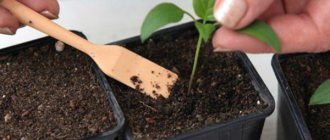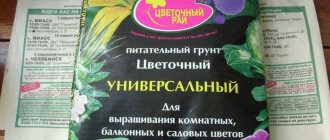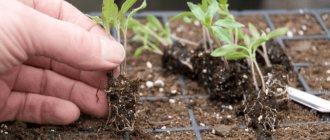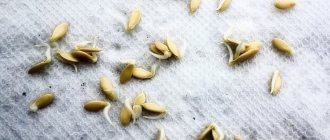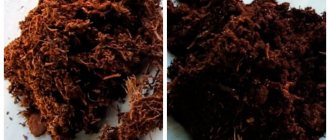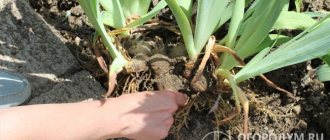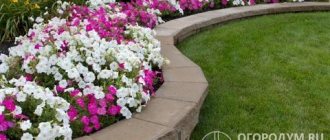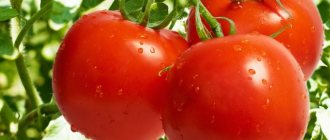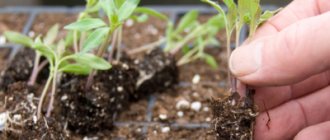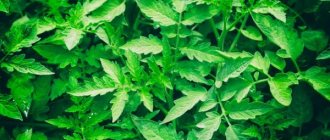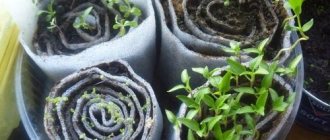Are there any benefits to picking and what are its harms?
Gardeners have different opinions about this procedure; there are supporters and opponents. Some believe that picking is necessary for the successful growth and development of plants, while others are confident that seedlings will grow well without additional human intervention.
But the following advantages of the process are still generally recognized:
- There is no need to thin out the sprouts in the future. Thanks to picking, all weak and underdeveloped seedlings are eliminated at an early stage. As a result, only strong plants remain, which are further grown to adulthood.
- Transplanted crops better tolerate further transplantation to a permanent location. Their root system easily adapts to a new environment.
- Picked seedlings after transplanting into open ground do not get sick, are highly resistant to external environmental conditions and diseases, and their productivity also increases.
- Plants do not stretch or overgrow. After picking, active formation of the root system begins, and the growth of the above-ground part slows down. Therefore, when the stems are stretched excessively, it is recommended to dive.
But the procedure also has disadvantages. The first is that the main root, which is pinched, loses the ability to grow to great depths and extract water from there. This is a minus, especially in hot times. But the problem can be solved by regular and abundant watering.
The second negative point is that there is a risk of seedling death. Although it is very low, it is still there. After all, replanting is always stressful for plants.
Mandatory and optional
Experts say that picking is a completely optional undertaking. However, most plants tolerate it well and produce a bountiful harvest - of course, if it was done correctly.
But there are exceptions - plants with very sensitive root systems, which will be discussed later. Now you need to decide whether picking is mandatory or you can do without it. There is no clear answer to this question, since each gardener has his own experience and views on this matter.
You can try picking on a small number of seeds first, look at the results and draw conclusions.
Tomatoes, for example, will not be harmed by this. Some not only pick them up, but also trim the roots, cut the stem, and hit them during flowering for better pollination.
Tomatoes respond to this painlessly and give a rich harvest in return. Of course, at first you shouldn’t use such radical methods, but you can try them without fear for your harvest, because this will only bring benefits.
Which crops require picking and which do not?
Not all plants need picking. The fact is that cultures have different root systems. For example, if a seedling has a very delicate root, it may simply not withstand such interference, and as a result the seedling will die.
There is definitely no need to pick crops such as:
- cucumber;
- melon;
- pumpkin;
- zucchini;
- watermelon.
When 3-4 leaves appear, they are successfully transplanted to a permanent place. Or they are sown immediately in open ground.
Those who grow tomatoes, eggplants, peppers, lobelia and petunia cannot do without picking.
Why is it necessary to pick petunia seedlings?
Petunia is sown for seedlings in late February - early March, this makes it possible to get flowering plants as early as May. And if an adult flower steadfastly endures the vagaries of nature and the influence of external factors, then picking tiny petunia seedlings requires patience and painstakingness.
Fine, almost dusty, seed material cannot always be distributed fairly evenly over the soil surface, so petunia seedlings look like a continuous carpet. Soon the sprouts will begin to compete for nutrients, light and moisture. A deficiency of at least one of the listed factors leads to seedlings stretching out, they become tall and thin.
The root system in such conditions is also not able to develop fully due to lack of free space.
On a note. Piping is the truncation of the main taproot to stimulate the growth of lateral shoots. This word also refers to the transplantation of young seedlings into individual or common containers, but of a larger size.
In addition, dense crops are unevenly illuminated by sunlight, and there is no air circulation among the sprouts. And this can provoke diseases.
Petunia sprouts from common seedling containers should be first picked into individual containers at the stage of 2-4 true leaves. For the first dive, these can be disposable cups with a volume of 0.15-0.2 liters.
Petunia seedlings grown by sowing seeds directly into separate pots or peat tablets are also subject to picking, but it is much easier to work with.
When should you dive?
Transplantation with root pinching is carried out approximately 3 weeks after the sprouts appear. During this period, the plants should grow 3-4 full leaves. It is not recommended to touch them before, but you should not be late with picking.
Transplantation is carried out not only specifically to improve crop growth, but in the following cases:
- seedlings grow too densely, which prevents them from developing normally;
- the sprouts began to hurt and die, so it is urgent to save healthy seedlings;
- The growth of seedlings is excessively rapid; they reach their height prematurely.
The procedure is usually performed once, but sometimes there is a need to repeat it, for example, if there is not enough space for the roots, the stems are strongly stretched upward
Optimal timing for picking petunia in 2022
Choosing the right timing of gardening activities is very important for the well-being of seedlings. When do you need to pluck petunia seedlings? This should be done when the young plant has three or four true leaves . This time usually occurs a month after planting.
It is important not to miss the right time for replanting, since due to the great density and growth of roots, the seedlings may wither, stretch out, and weaken.
You can also choose favorable days for the procedure using the 2022 Lunar calendar:
- in February: 5, 6, 7, 8, 9, 18, 19, 20, 21, 22, 23;
- in March: 8, 9, 10, 11, 13, 14, 15, 17, 18, 19, 20, 21, 22, 23, 26, 27, 28, 29;
- in April: 5, 6, 7, 9, 10, 11, 19, 20, 23, 24, 25;
- in May: all days except the 15th and 29th.
Methods for picking plants
There are 3 methods for picking seedlings:
- Pike. You can use a small stick as a pike. With its help, they loosen the soil around the plant and pick up the root without causing severe damage. Before the procedure, it is important to water the soil well. For small seedlings, this technique is simply irreplaceable.
- Finger method. Similar to the first method, but instead of a pike, your own fingers are used. With their help, bushes are removed, and then a hole is made in the new soil, where they are then replanted. It is most convenient to pick large seedlings with your fingers.
- Plank. For this procedure, you will need a thin small board, with which you can remove several plants at once. Thanks to this technique, several crops can be transferred at once. But the quality of such picking is worse than in previous cases.
For transplantation you will need to prepare equipment. You will need water, large containers, soil mixture and a device with which to remove seedlings.
What is meant by the term “picking”
This word comes from the French “piquet” and means “peg”, in other words, a thin stick with which, in fact, such manipulation is carried out. During picking, seedlings are moved from tiny pots, in which seeds were once densely sown, into larger containers. At the same time, the main root of each seedling is pinched about a third of its length.
Preparing soil and containers
The soil for seedlings needs to be saturated with useful substances. During the picking process, plants experience stress, they have to adapt to a new place, so nutrition is very important for them.
Gardeners advise purchasing ready-made soil in the store. It contains all the necessary elements, and there are definitely no pathogenic microorganisms and weed seeds. You can take soil from your own plot, enriching it with mineral or organic fertilizers.
You can use different containers for picking depending on your taste. You can buy them in specialized stores or adapt something at hand.
For example, many people prefer to plant seedlings in plastic cups, having previously made several holes in the bottom to allow excess moisture to escape.
Gardeners also love peat pots because they can then be planted directly together with seedlings in open ground.
You don’t have to pull out the plants, which greatly simplifies the task and prevents damage to the root system.
How to pick correctly
To carry out the picking, you will need containers, fresh soil mixture, water and a picket - the same stick that gave the name to the procedure. Its length should be at least 10-12 cm.
Advice. The role of a picket is successfully performed by a pencil sharpened in the shape of a peg or a nail file from a manicure set.
An hour before the start, the seedlings are watered. The following is the operating procedure:
- The seedlings are dug up one by one with a picket and pry it up from below, removing them from the soil along with the soil adhering to the root hairs. At this stage, sick, underdeveloped and overly elongated ones are rejected. A third of the root is pinched with a fingernail so that the remaining part will develop abundant branching. To avoid mutilation of the fragile stem, the seedling is taken by the cotyledon leaves.
- Mark a new place for the seedling and use a picket to make a hole large enough for the main root to straighten out without bending. The seedling is buried almost to the cotyledons. If the soil settles after watering, you will need to add more.
- Using the same picket or finger, gently press the soil to the roots.
- At the end of the work, the seedlings are watered generously and the light level is reduced for 3-5 days.
The process of picking seedlings
Attention! Reduce ventilation in the area where the sprouts will stand, otherwise air currents will carry water vapor away from the plants.
Picking instructions
The transplant procedure consists of several successive stages. You need to do the following:
- Water the crop. This is a mandatory condition regardless of which method you plan to use for picking.
- Determine the planting depth so that the plant is not cramped and the root system can expand freely in the new recess.
- Remove the bush from the pot. This is the most crucial moment, because there is a risk of damaging the roots. Carefully loosen the soil located near the crop, trying not to touch the root system, and remove it.
- Pinch the spine by 1/3.
- Transplant the plant into a new container with a larger size, carefully straightening the roots, and fill the hole with soil.
Depending on the specific crop, the picking process may vary slightly.
For example, sometimes it is necessary to pour water into the hole before transplanting or water the seedlings after the procedure.
A few final tips
- Before picking, do not forget to thoroughly moisten the soil with seedlings. The roots of the seedlings are still weak and can be damaged if they are removed from dry, dense soil.
- Do not ignore the procedure for pinching the main root. Sometimes a root that is too long is simply bent, but this can negatively affect the further development of the plant.
- Do not leave a long stem above the soil surface when picking, as this interferes with the development of adventitious roots. The exception is the capricious pepper seedlings, which do not like excessive deepening.
- For better growth, picked seedlings can be watered with a solution of “Kornevin” or its analogue, containing the hormone heteroauxin.
Caring for seedlings after picking
If anyone thinks that after transplanting they can put the seedlings on the windowsill and only water them periodically, they are deeply mistaken. After picking, plants need careful care. After all, the following measures still need to be taken:
- organize optimal lighting;
- water;
- apply fertilizers;
- ensure that crops are not exposed to pests and diseases.
Harden off seedlings
If necessary, re-picking may be necessary in the future.
Is it necessary to bury seedlings when picking?
To obtain stronger and stockier plants, when picking, seedlings are buried almost to the cotyledon leaves.
When picking, seedlings are buried almost to the cotyledon leaves.
The exception is pepper. It is believed that he reacts painfully to deepening; Moreover, this culture does not form adventitious roots; the seedlings, even in cramped conditions, do not stretch particularly - there seems to be no need to bury them.
Picking is important for plants that are sown superficially (petunias, lobelias and others). If you nevertheless decide to grow these crops without picking, pour the soil for sowing into a container in such a way that you can later add soil, burying the seedlings with bedding. And read the notes based on practical experience:
- Petunias: grow with or without picking?
- Petunias. To new apartments, or Why picking, transshipment, transplantation is needed
Common mistakes
Often gardeners use non-sterile soil for petunias, and this causes the development of various diseases.
After picking, the seedlings must be well watered, but many do not do this.
And finally, picking petunias is a very painstaking process, carried out according to the lunar calendar and requiring patience and time. Therefore, there is no need to rush, because each sprout must be carefully removed from the ground and transferred to a new place without damaging it.
What kind of soil does petunia need?
The structure of the substrate for transplantation must be light and loose - the soil must be well permeable to air and water. The soil must be fertile and neutral in acidity. You can also use a ready-made substrate for flowering crops.
Experienced and skilled gardeners often prepare the soil for seedlings themselves. For petunia, a substrate consisting of:
- 1 part high peat;
- 1 part humus;
- 1 part sand.
The prepared mixture must be calcined in the oven, or poured with a solution of Fitosporin. It would be safer to first ignite the soil and then pour it with the solution to kill all the bacteria.
In what cases is it necessary to pluck petunia seedlings?
Very small seeds of this flower are most often sown in one common container, and then the sprouts that have risen are planted in separate glasses. Petunia must be picked:
- When sowing is dense, the plants experience a lack of light - the seedlings begin to stretch, and the seedlings become weak and thin. This petunia is not suitable for planting in a flower bed.
- If many weak seedlings have sprouted and have no chance of survival. When picking, only the strongest sprouts are left.
Answers to frequently asked questions
Often, beginning gardeners are interested in how to organize watering of tender sprouts so as not to nail them to the soil, and to give them enough moisture.
It is most convenient to water petunia seedlings using a syringe. This way you can supply water directly to the root of the plant. You can also water petunias through a tray.
Many people are interested in which ready-made fertilizers are best to use for petunia seedlings.
Fertilizers for foliar feeding “Kristalon” and “Uniflora micro” are popular. Such fertilizers can be applied twice a week.
It happens that petunia seedlings become infected with blackleg. Why and what should be done?
A fungus called blackleg begins to spread due to excessive dampness. All diseased plants will have to be destroyed.
